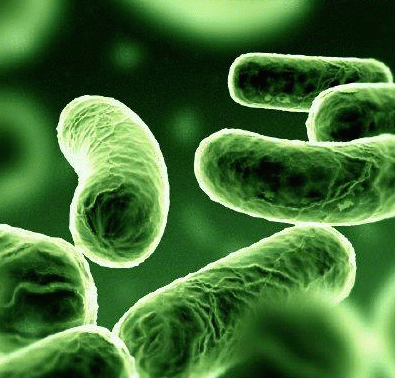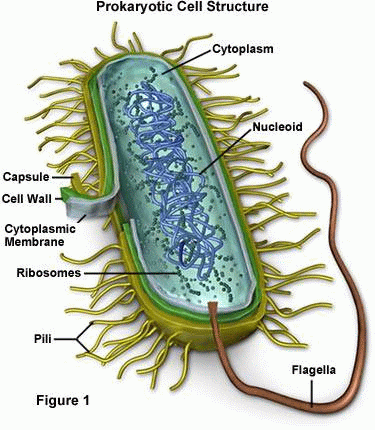Hydrocarbon Degrading Bacteria-Taxonomy & Facts of Bacteria
Bacterial Degradation in PDF

|
Hydrocarbon Degrading Bacteria.pdf Size : 190.145 Kb Type : pdf |


Hydrocarbon Degrading Bacteria-Taxonomy & Facts of Bacteria.
Brief facts
Bacteria generally degraders in aquatic systems such as oceans, ponds and other water reservoir. They also possess diverse metabolic pathways which is not seen in fungi which allows them to utilize most recalcitrant petroleum hydrocarbons.
- Bacterial degradation of aromatic compounds can be divided into three steps:
1. modification and conversion of the many different compounds into a few central aromatic intermediates (ring-fission substrates); this step is referred as peripheral pathway and involves considerable modification of the ring and/or perhaps elimination of substituent groups;
2. oxidative ring cleavage by dioxygenases, which are responsible for the oxygenolytic ring cleavage of dihdyroxylated aromatic compounds (catechol, protocatechuate, gentisate);
3. further degradation of the non-cyclic, non-aromatic ring-fission products to intermediates of central metabolic pathways.
- Long-chain hydrocarbons (C10-C18) can be used rapidly by many high G+C Gram-positive bacteria. Only a few bacteria can oxidize C2-C8 hydrocarbons. Degradation of n-alkanes requires activation of the inert substrates by molecular oxygen with help of oxygenases by three possible ways that are associated with membranes:
1. Monooxygenase attacks at the end
producing alkan-1-ol:
R-CH3 + O2 + NAD(P)H + H+ → R-CH2OH
_ NAD(P)+ + H2
2. Dioxygenase attack produces the
hydroperoxides, which are reduced to yield also alkan-1-ol:
R-CH3 + O2 → R-CH2OOH + NAD(P)H + H+
→ R-CH2OH + NAD(P)+ + H2O
3. Rarely, subterminal oxidation at C2 by monooxygenase yields secondary alcohols.
- It is important to keep in mind that many strains within one species of bacteria usually exist. Usually, only some of strains are capable of hydrocarbon degradation and some of strains can cause opportunistic infections in humans and animals.
List of bacterial genera important in oil bioremediation
- Micrococcaceae
- Arthrobacter Arthrobacter spp. were shown to degrade various aromatic hydrocarbons such as phenanthrene (Ref.) and others ( Ref.).
- Micrococcus Isolated from oil-biodegrading consortia in marine environment ( Ref.).
- Brevibacterium These bacteria were isolated from petroleum-degrading consortia ( Ref.).
- Brachybacterium B. phenoliresistens was isolated from an oil-contaminated coastal sand sample ( Ref.).
- Cellulomonas Sediment hydrocarbon-utilizing bacteria ( Ref.).
- Janibacter Implicated in degradation of polycyclic hydrocarbons (PAHs) ( Ref.).
- Terrabacter Implicated in degradation of polycyclic hydrocarbons (PAHs) in marine sediments ( Ref.).
- Mycobacterium Some species can utilize polycyclic hydrocarbons (PAH) and other pollutants ( Ref.).
- Corynebacterium Isolated from oil-degrading consortia ( Ref.).
- Nocardioides Most species are free-living in soil and water. Some species can utilize polycyclic hydrocarbons (PAH) and other pollutants ( Ref.).
- Rhodococcus Some species can utilize polycyclic hydrocarbons (PAH) and other pollutants ( Ref.).
- Nocardia ( Ref.).
- Smaragdicoccus ( Ref.).
· Cyanobacteria Cyanobacteria can play important role in oil-degrading consoria by not only oxydizing oil components but also by providing microbial community with nitrogen
Bacteroidetes/
Chlorobi group
- Flavobacteria
- Chryseobacterium Were isolated from stable carbazole-degrading consortium with Achromobacter (Guo W et al, 2008) and other oil-degrading bacterial communities (Ref.).
- Flavobacterium Some strains are capable of degrading polycyclic aromatic hydrocarbons and heterocyclics (Ref.).
- Yeosuana A marine bacterium, Y. aromativorans GW1-1T, capable of degrading benzo[a]pyrene (BaP) (Ref.).
- Bacillaceae Endospore-producing; mostly saprophytes from soil, but a few are insect or animal parasites or pathogens.
- Bacillus Common in soil; several species (B. subtilis, B. cereus and others) were shown to use naphthalene, pyrene and other aromatics (Ref.).
- Geobacillus Endospore-forming, thermophilic bacteria capable of utilizing long-chain alkanes (Ref.).
- Staphylococcaceae
- Staphylococcus Some species are opportunistic pathogens of humans and animals. Pathways of utilization of phenanthrene and other aromatic compounds by these organisms was studied (Ref.).
- Alphaproteobacteria Comprised mostly of two major phenotypes: purple non-sulfur bacteria and aerobic bacteriochlorophyll-containing bacteria.
- Sphingomonadaceae
- Sphingomonas Degrade a broad range of substituted aromatic compounds ( Ref.).
- Sphingobium Degrade a range aromatic compounds ( Ref.).
- Rhodobacteraceae
- Paracoccus Hydrocarbon-utilizing bacteria ( Ref.).
- Stappia Alkaliphilic and halophilic hydrocarbon-utilizing bacteria ( Ref.).
- Roseobacter Marine hydrocarbon-utilizing bacteria ( Ref.).
- Rhodospirillaceae
- Thalassospira A polycyclic aromatic hydrocarbon-degrading marine bacterium ( Ref.).
- Tistrella A phenanthrene-degrading marine bacterium ( Ref.).
- Brucellaceae
- Ochrobactrum A polycyclic aromatic hydrocarbon-degrading marine bacterium ( Ref.).
- Rickettsiales
- Betaproteobacteria Comprised of chemoheterotrophs and chemoautotrophs which derive nutrients from decomposition of organic material.
- Alcaligenaceae
- Achromobacrer Were isolated from stable carbazole-degrading consortium with Chryseobacterium (Guo W et al, 2008) and other oil-degrading bacterial communities (Ref.).
- Alcaligenes Implicated in degradation polycyclic aromatic hydrocarbons (PAH) from oil and other pollutants (Ref.).
- Comamonadaceae
- Acidovorax Has been found in consortia utilizing heterocyclic aromatics (Ref.)
- Polaromonas Has been shown to utilize naphthalene, benzene, toluene (Ref.)
- Burkholderiaceae
- Burkholderia Found in consortia of microorganisms degrading polycyclic hydrocarbons (PAH) and other environmental pollutants ( Ref.).
- Ralstonia Free-living forms are known to utilize polycyclic hydrocarbons (PAHs) ( Ref.).
- Rhodocyclaceae
- Azoarcus Gram-negative, facultatively anaerobic bacteria including species which are often associated with grasses and which fix nitrogen as well as species which anaerobically degrade toluene and other mono-aromatic hydrocarbons ( Ref.).
- Thauera Gram-negative, rod-shaped bacteria able to anaerobically oxidize and degrade toluene ( Ref.).
- Delta-
proteobacteria Represented by morphologically diverse, anaerobic sulfidogens; some members of this group are considered bacterial predators, having bacteriolytic properties. - Geobacteraceae
- Geobacter Anaerobic, metal-reducing bacteria in the family Geobacteraceae. They have the ability to oxidize a variety of organic compounds, including aromatic hydrocarbons ( Ref.).
- Desulfobacteraceae
- Desulfobacterium Anaerobic, metabolizes C12-C20 alkanes ( Ref.).
- Desulfobacula Anaerobic, metabolizes toluene and benzene ( Ref.).
- Desulfotignum A Gram-negative, sulphate-reducing bacterium ( Ref.).
- Epsilon-
proteobacteria Consists of chemoorganotrophs usually associated with the digestive system of humans and animals. - Gamma-
proteobacteria Comprised of facultatively anaerobic and fermentative gram-negative bacteria. - Piscirickettsiaceae
- Cycloclasticus Marine bacteria; play a major role in degrading polycyclic hydrocarbons (PAH) from crude oil in marine environment ( Ref.).
- Pseudomonadaceae
- Pseudomonas Numerous strains are most studied oil biodegraders; many strains are patented and are included in commercial bioremediation mixtures ( Ref.).
- Alteromonadaceae
- Marinobacter Implicated in degrading polycyclic hydrocarbons (PAH) and other environmental pollutants ( Ref.).
- Pseudoalteromonadaceae
- Pseudoalteromonas Marine oil-degrading bacteria ( Ref.).
- Pasteurellaceae
- Pasteurella Was shown to degrade fluoranthene ( Ref.).
- Shewanellaceae
- Shewanella Marine organisms frequenly isolated from oil-contaminated sites ( Ref.).
- Moraxellaceae
- Acinetobacter Abilities for bioremediation of oil were documented ( Ref.).
- Moraxella Plasmid-mediated degradation of hydroxylated, methoxylated, and carboxylated benzene derivatives in Moraxella spp. were documented ( Ref.).
- Halomonadaceae
- Alcanivoracaceae
- Alcanivorax Present in un-polluted sea water in low numbers; principal carbon and energy sources are linear-chain alkanes and their derivatives ( Ref.).
- Oceanospirillaceae
- Thalassolituus Marine hydrocarbonoclastic alkane-degrading bacteria ( Ref.).
- Oleispira Marine hydrocarbonoclastic bacteria ( Ref.).
- Neptunomonas Marine hydrocarbonoclastic bacteria ( Ref.).
- Oleiphilaceae
- Oleiphilus Marine obligate hydrocarbon-degrading bacteria ( Ref.).
- Xanthomonadaceae
- Rhodanobacter Rhodanobacter spp. is capable of utilizing benzo[a]pyrene (BaP) ( Ref.).
- Stenotrophomonas S. maltophilia is capable of utilizing various polycyclic aromatic hydrocarbons (PAH) ( Ref.).
- Xanthomonas Produce a yellow pigment; some species are pathogenic to plants. Biodegradation of complex polycyclic aromatic hydrocarbons was studied ( Ref.).
- Arenimonas Was isolated on nutrient agar from a soil sample collected from an oil-contaminated site ( Ref.).
- Zetaproteobacteria
Written by -Safar Mohammad Khan,Green Apple Environmental Technologies